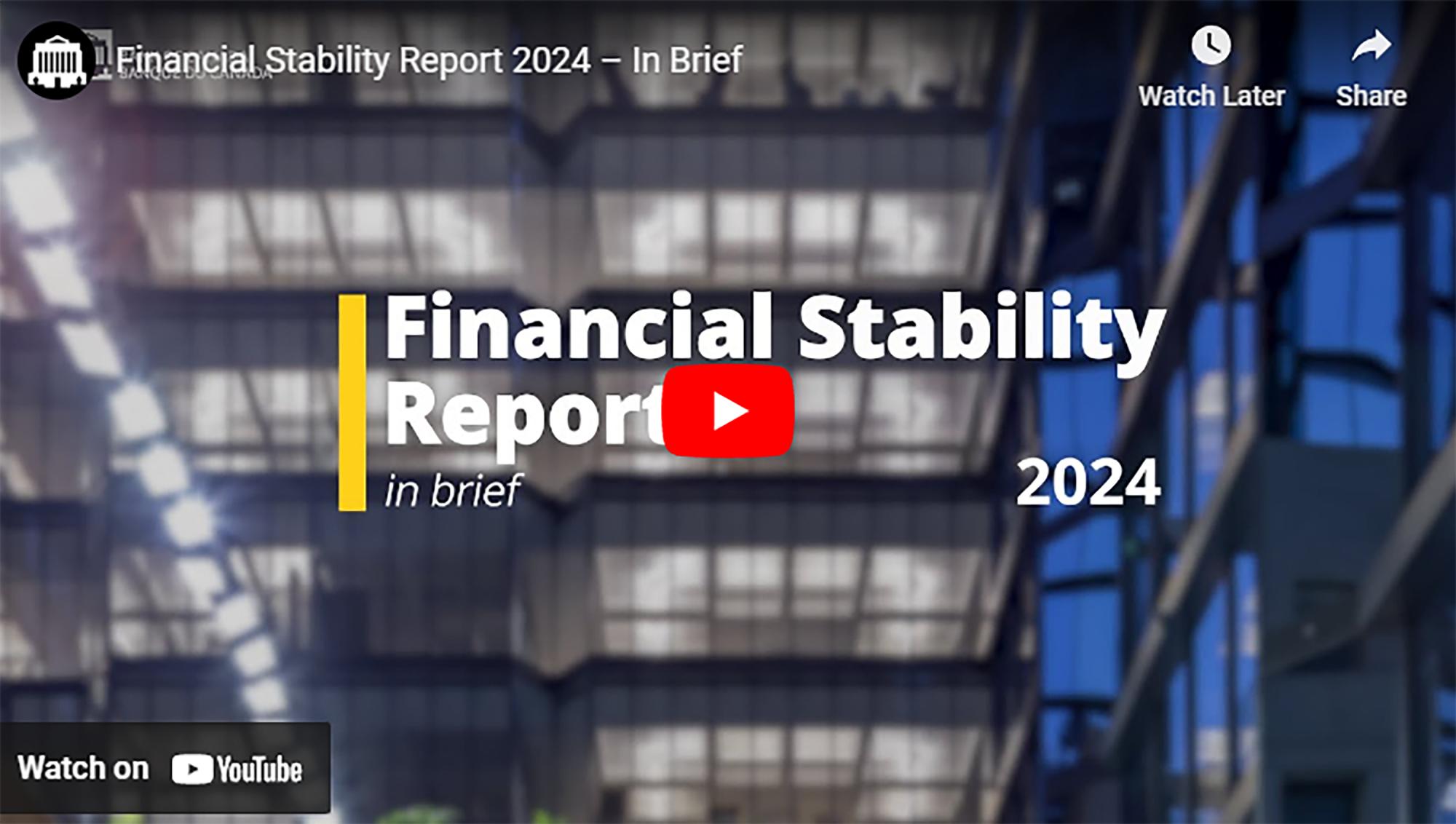
Financial system
The Bank of Canada plays an essential role in promoting the stability and efficiency of the Canadian financial system. In 2024, conditions in global financial markets generally improved. Over the year, inflation declined, and central banks began lowering their policy interest rates. However, geopolitical tensions increased and contributed to market uncertainty.
Against this backdrop, Canada’s financial system remained resilient. The Bank urged financial system participants to continue actively planning for future periods of stress.

Senior Deputy Governor Carolyn Rogers speaks to the Economic Club of Canada in November about Canada’s mortgage market and how it has evolved over time.
Credit: Stacey Newman
Assessing risks to financial stability in Canada
Evolving the Bank’s risk assessment framework
This year, the Bank’s Financial System Review was renamed Financial Stability Report to reflect the evolution of how it assesses risks to financial stability in Canada. The Report presents the Bank’s assessment of these risks using an enhanced, system‑wide surveillance framework, which enables a rigorous, cross-sectoral perspective.
The 2024 Report concluded that although the Canadian financial system remained resilient overall, two key risks to stability exist: the ongoing adjustment of households and businesses to higher interest rates, and stretched asset valuations.
Monitoring the ongoing adjustment to higher interest rates
The Bank analyzed a wide range of data to assess how households and businesses were adjusting to higher interest rates.
This analysis helped the Bank understand the diverse experiences of those facing increases in mortgage costs. For example, some households adjusted their mortgage payments in advance to reduce payment shock at renewal, while first‑time homebuyers relied more heavily on parental support than in the past to quality for a mortgage.1 Also, mortgage stress tests have improved the resilience of borrowers facing higher interest rate payments.2
Assessing the risks associated with overpriced assets
The Bank warned that a sharp correction in asset values, coupled with increased leverage in the non‑bank financial intermediation sector, could lead to system‑wide stress. It also noted that because the financial system is highly interconnected, a problem in one sector could spread to other sectors.
Bank staff examined the interdependencies between banks, non‑bank financial institutions and markets. This included work that explored:
- how to measure contagion risk among Canadian financial institutions3
- how Canadian banks are exposed to foreign non‑bank financial institutions4
- how the increasing use of leverage for relative‑value trading strategies by non‑bank financial institutions could affect financial stability5
- how Canadian life insurers manage liquidity risks during periods of stress
- how market structure affects liquidity in government bond markets6
Collaborating to enhance the Bank’s financial stability assessments
The Bank continued to lead the Heads of Regulatory Agencies Committee and the Systemic Risk Surveillance Committee. Through these federal‑provincial forums, public sector authorities share information and work together to promote the resilience of Canada’s financial sector.
The Bank also began working with domestic authorities and the International Monetary Fund to complete an in‑depth assessment of Canada’s financial sector, which is conducted every five years. The report will be published in 2025.7
Analyzing the link between monetary policy and financial stability
The financial system plays a critical role in transmitting monetary policy to the economy. Therefore, the Bank considers risks to the financial system when making its monetary policy decisions. In 2024, Bank staff used microdata on individual loan characteristics—such as credit card spending and the timing of mortgage renewals—to look at how changes in monetary policy affect the outlook for consumption.8
The Bank also continued to examine how monetary policy and macroprudential policies work together to ensure both price stability and financial stability.9
Promoting the resilience and efficiency of the financial system
Fostering financial stability through periods of stress
Part of the Bank’s financial stability mandate is to oversee Canadian financial market infrastructures (FMIs) that have the potential to pose widespread risk to Canada’s payment systems. In 2024, the Bank took important steps toward ensuring the four payment systems that were designated in 2023 as prominent payment systems meet the Bank’s standards for risk management.
As the resolution authority for FMIs, one of the Bank’s responsibilities is to plan how it will respond in the unlikely event that one of Canada’s designated FMIs fails. In 2024, the Bank developed resolution plans for four domestic FMIs. These plans explain how an FMI’s critical functions will be maintained in times of extreme stress.
Enhancing systems that support efficient market functioning
The Bank is modernizing the critical systems that support its financial market and banking operations. In 2024, it reintroduced its Securities Lending Program to support the smooth functioning of the Government of Canada bond market.10
The Bank continued to work directly with industry through its leadership of the Canadian Fixed‑Income Forum. In 2024, the Bank formed a new working group, the Collateral Infrastructure and Market Practices Advisory Group, to provide guidance and to support changes to Canada’s financing and collateral infrastructure and market practices.11
Completing the transition to the new interest rate benchmark
As co-chair of the Canadian Alternative Reference Rate Working Group (CARR), the Bank helped complete the multi‑year transition of the Canadian financial system from the Canadian Dollar Offered Rate (CDOR) to the Canadian Overnight Repo Rate Average (CORRA). The Bank is also the administrator for CORRA.
In June 2024, CDOR and bankers’ acceptances (formerly a key product in money markets) were discontinued. As a result, over $20 trillion of exposures across derivatives, securities and loans transitioned to CORRA. Having fulfilled its mandate, CARR was disbanded in October 2024.
Looking forward
In 2025, the Bank will:
- complete a review of its liquidity facilities to take on board lessons learned from the COVID‑19 pandemic and ensure that these facilities align with market developments
- build on technology and process improvements that support the Bank’s financial market operations and Canada’s payment systems
- work with industry to influence structural change in the Canadian market, including encouraging broad adoption of the new Canadian tri‑party repurchase agreement service, and completing a review of the CORRA methodology.
More information
“Canada’s mortgage market—A question of balance” (remarks by Senior Deputy Governor Carolyn Rogers)
- 1. J. Allen, K. Carmichael, R. Clark, S. Li and N. Vincent, “Housing Affordability and Parental Income Support,” Bank of Canada Staff Working Paper No. 2024‑28 (July 2024).[←]
- 2. J. Hartley and N. Paixão “Mortgage stress tests and household financial resilience under monetary policy tightening,” Bank of Canada Staff Analytical Note No. 2024‑25 (November 2024).[←]
- 3. G. Halaj and R. Hipp, “Decomposing Systemic Risk: The Roles of Contagion and Common Exposures,” Bank of Canada Staff Working Paper No. 2024‑19 (May 2024).[←]
- 4. C. Friedrich, H. Friedrich, N. Lawrence, J. Cortes Orihuela and P. Tian, “The International Exposure of the Canadian Banking System,” Bank of Canada Staff Working Paper No. 2025‑01 (January 2025).[←]
- 5. A. Uthemann and R. Vala, “How big is cash-futures basis trading in Canada’s government bond market?” Bank of Canada Staff Analytical Note No. 2024‑16 (June 2024).[←]
- 6. J. Sandhu and R. Vala, “Could all‑to‑all trading improve liquidity in the Government of Canada bond market?” Bank of Canada Staff Analytical Note No. 2024‑17 (July 2024).[←]
- 7. For more, see the Financial Sector Assessment Program page of the International Monetary Fund’s website.[←]
- 8. P.‑Bouras, J.‑Saldain, X.‑Guo, T.‑M.‑Pugh and M.‑teNyenhuis, “Impacts of interest rate hikes on the consumption of households with a mortgage,” Bank of Canada Staff Analytical Note No. 2024‑14 (June 2024).[←]
- 9. Duprey,‑T., Y.‑Terajima and J.‑Yang, “Interaction of Macroprudential and Monetary Policies: Practice Ahead of Theory,” Bank of Canada Staff Discussion Paper No. 2024‑18 (December 2024).[←]
- 10. See Bank of Canada, “Bank of Canada launches Securities Lending Program as replacement to Securities Repo Operations” (market notice, September 24, 2024).[←]
- 11. For more information, see Collateral Infrastructure and Market Practices Advisory Group - Bank of Canada.[←]
